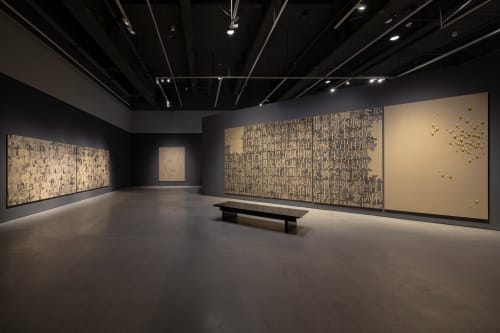A little more than 30 years have passed since Kim Tschang-Yeul’s retrospective exhibition at the National Museum of Modern Art in Gwacheon in 1993. Now, the National Museum of Modern and Contemporary Art (MMCA) in Seoul is staging a new survey show. This is a rare opportunity to experience Kim’s oeuvre across the various phases and periods of his career, including previously unseen pieces from his Paris studio, uncovered after his passing in 2021.
Kim is recognized as one of the key figures in Korean monochrome painting, known as dansaekhwa, an abstract art movement that emerged in the 1970s. The traumatic experiences of his early life are visibly reflected in his informel paintings from the 1950s and early 1960s. His ‘Rite’ series from the early 1960s, in particular, is characterized by rough painterly textures and intense colour contrasts across flat surfaces. In June 1965, following his participation in the International Association of Art under UNESCO, Kim relocated to New York – encouraged by his mentor, Kim Whanki. From the mid- to the late 1960s, he distanced himself from informel aesthetics and the remnants of war, experimenting with new materials such as Plexiglas and exploring more geometric forms. And between the late 1960s and 1973, he developed his signature water droplet motif, marking a significant, sustained shift in his practice.
Although Kim remains best known for his water drop paintings, this new exhibition provides a broader view of his artistic pursuits, tracing the development of his unique visual language through out his career. It includes his ‘Recurrence’ series, in which droplets are juxtaposed with passages from classical Chinese texts, influenced by his grandfather’s calligraphic practice. Temporality in his work transforms into a temporality, while the repetitive and performative act often evokes the aesthetics of dansaekhwa. Kim’s work embodies the paradox of visibility: the impossibility of truly seeing water drops versus the illusion – and anti-illusion – of their presence.
On the occasion of the 2023–24 exhibition ‘Water’ at the Boghossian Foundation in Brussels, we had the honour of presenting 14 works by the great Korean painter Kim Tschang-Yeul. His evocative depictions of water drops found a natural and touching resonance with the setting of the Villa Empain.
Kim’s life was shaped by a succession of struggles and exiles. Aged just 15, he fled his village in North Korea under the cover of night. He never saw his family again – most poignantly, he lost all contact with his beloved grandfather, who had founded the village school and inspired Kim’s vocation. Later, forcibly conscripted to fight against the communists, the artist witnessed the loss of his comrades and narrowly escaped death on the front line.
Kim devoted 50 years to the development of a singular and remarkable body of work – one centred entirely on alone motif: the water drop. He painted hundreds of thousands of water drops – each alike, each distinct. With the precision of an illusionist, he deployed his implacable technique, introducing subtle variations in format and medium. The result is work of extraordinary visual impact, a compelling testament to his painterly rigour and mastery of light and shadow.
‘Since 1971, this has been my only path’, he remarked during a press conference held for the inauguration of his museum in Jeju, Korea, in 2016. ‘That’s it – this is what I am meant to do’. The drops, he insisted, ‘carry no meaning’, nor does the endless repetition of this motif over the years.
In his rare confiding moments, Kim acknowledged that the water drops served to ‘erase the anxieties’ of a ‘needlessly complicated’ life and to help him ‘live without fear’. His unique body of work reveals an inconsolable man in search of a lost paradise. Kim’s work, poised between dolourism and mysticism, is at once masterful and enigmatic.
Much of Kim Tschang-Yeul’s work presents the dual nature of water’s austerity (colourlessness) and sensuality (fullness). His paintings of water droplets are often rounded (facing the viewer: forward energy) and flat on the canvas (behind: receding energy); they are light and dark, transparent and refractive. The dialectic between tension and collapse, form and formlessness, reminds me that living can be abstracted into cycles of stasis, crisis and transformation. Kim’s work forces me to pause, to meet beauty. The cool grey-white-silver reflections on the surface of the droplets that contrast with the warmth of the yellow-orange-brown refracted light within the paintings remind me that even the smallest prism can possess a luxurious, enigmatic, time-stopping magnetism.
The shallow depth of field in Kim’s works means our attention cannot escape into the painting. Yet, as with other Korean artists retroactively described as making dansaekhwa, or monochrome, paintings, the abstraction and formality of the work offer a kind of respite from sensory overload. The crowds of water droplets, individual yet lacking individuality, set on top of and against backdrops of Chinese characters or newsprint in Waterdrops (1983), present what feels like a harmonious juxtaposition of the natural and the cultural. A co-existence in the same space without necessarily speaking to each other.
In the paintings, water appears to be captured before, during or after implied moments of movement. The drops may soak the paper, magnify or distort newsprint letters or appear to cling roundly to a surface right before they drip. Looking at Kim’s paintings, I remember that water and oil repel each other, which reminds me that not everything can coalesce, merge and dissolve.
—Sun Yung Shin, Yeon Shim Chun, and Louma Salamé


